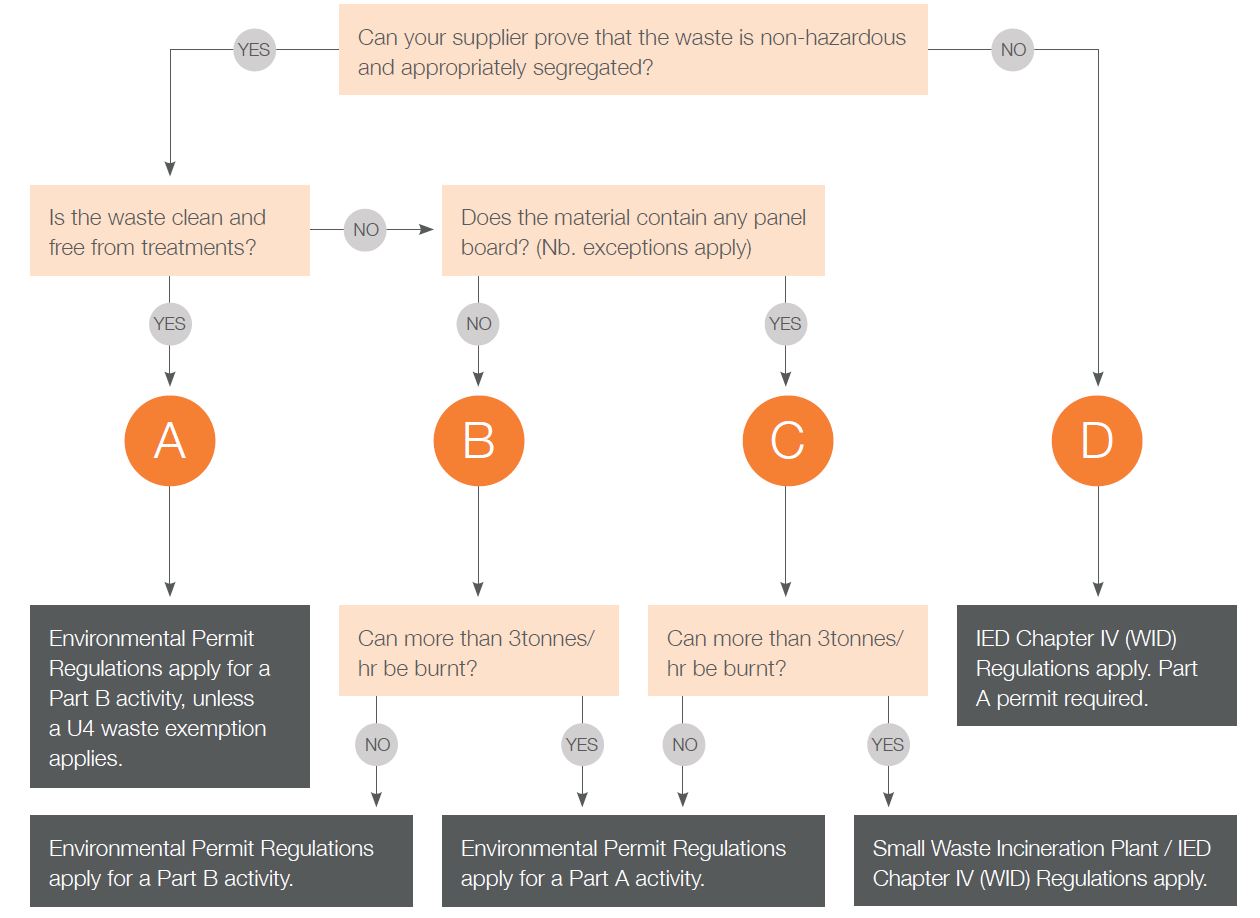For many, burning recycled waste wood is a great choice, as it is a low cost and readily available biomass fuel. However, it’s important to make sure you’re properly permitted before you even take delivery. There are four classes of waste wood:

These grades are established in the British Standard BSI PAS111:2012, adopted by the Wood Recyclers Association as the industry standard for grading used woods.
Does burning waste wood affect my RHI payments?
If your RHI emissions certificate, states your boiler is capable of burning waste wood, you must still apply for the relevant environmental permit before doing so. Obtaining an environmental permit is part of maintaining your legal obligations beyond simple compliance with the RHI. If waste wood is not listed on your boiler’s emissions certificate, an appropriate environmental permit can be used to demonstrate compliance with RHI regulations. Once you are appropriately permitted, you must declare to Ofgem that you have changed fuel type in order to maintain your RHI compliance and to continue receiving payments. There may be more record keeping necessary and, in most circumstances, fuel testing will be required to meet RHI regulations.
Which grade should I burn?
The simplicity and lower cost of burning Grade A mean it’s often the best choice. Many commercial boilers accredited to the RHI can burn this grade of wood without any equipment modification, although settings may change. We advise that you check with us first before deciding to burn this material. In order to legally burn Grade A wood, you will need to obtain a Part B environmental permit (or a variation to an existing Part B permit), carry out regular monitoring of emissions and you’ll need to keep and report the results to your local authority when requested.
The regulations regarding burning Grades B, C or D waste wood are more stringent and therefore expensive to implement and maintain. In many cases, boiler modifications will be needed to ensure the boiler is unharmed by burning this fuel. Additionally, the more contaminated grades fall under the Waste Incineration Directive regulations, which require specialist boiler plant.
What permit do I require?
Use this flowchart to determine what regulations apply when burning different grades of waste wood:

For these reasons, most businesses opt to burn Grade A waste wood having either applied for a Part B permit from their local authority or notifying their local authority that they have a U4 exemption.
What is a U4 exemption
If your boiler uses less than 50kg/hr of fuel and is less than 400kW net thermal input, you can burn some Grade A waste wood without a Part B permit by applying for a U4 exemption. You will need to notify your local authority what you are burning, as well as submitting site plans and fuel specifications etc. to justify your statements.
How do I get a Part B Permit?
By applying to either your local authority or the Environment Agency, depending on your existing situation. You will need to submit the following:
- An application form
- Site plans
- Design details of the boiler
- Fuel specifications
- Details on your management system
- Supplier details
- Emissions calculations
It normally takes around a month to complete the process, but sometimes it can take up to four months. You will also need to provide an environmental policy if you are proposing to burn Grade A waste wood near a Site of Specific Scientific Interest (SSSI), or similarly classified area. In some cases, a site visit by your local authority is required. More stringent permitting regulations apply if the combined thermal input of all boilers on site, which burn waste wood, exceeds 3tonne /hr fuel consumption.
How can FEC Energy help?
We will oversee the entire application process, liaise with your local authority on your behalf to ensure that your submission is straightforward and that the permit is issued as quickly as possible. We undertake all the calculations, provide the required documentation and advise you on the necessary changes to management practices. Once the permit has been issued, we can also provide advice on your on-going monitoring responsibilities and undertake these for you.
What we do:-
- Identify which organisation/authority to apply to.
- Check for any local SSSI’s, or other local protected areas, which may affect your application.
- Discuss your application with your Local Authority to ensure all requirements are met.
- Determine if a site visit is needed and represent you during the visit if required.
- Complete the application form.
- Complete the paperwork required including process descriptions, fuel specifications, emission calculations, stack height calculations, site plans, location plans and additions to management systems etc.
- Advise you on the procedures and requirements you will need to implement on-site to adhere to the regulations.
- Ensure you pay the correct fees to the Local Authority.
- Describe your on-going monitoring requirements.
- Provide you with documentation to enable you to comply with ongoing monitoring requirements.
Pricing
Contact us for an up to date quotation and to discuss any questions you may have about how to begin the process of burning Grade A waste wood in your biomass boiler.




